Abstract
BACKGROUND--DDD pacing has been advocated as an effective treatment for drug refractory obstructive hypertrophic cardiomyopathy. This study reports the outcome of pacing in 56 patients with refractory symptoms referred to four tertiary centres. METHODS--Core data on symptoms, drug burden, and left ventricular outflow tract gradient were recorded. Patients underwent a temporary pacing study with optimisation of the atrioventricular (AV) delay for greatest gradient reduction without haemodynamic compromise. Patients were assessed after implantation in terms of changes in symptoms, drug load, and outflow tract gradient. RESULTS--56 patients underwent pacing assessment. The mean (SD) left ventricular outflow tract gradient before pacing was 78 (31) mm Hg. At temporary study the mean (SD) left ventricular outflow tract gradient was 38 (24) mm Hg with a median (range) optimised sensed AV delay of 65 (25-125) ms. Fifty three patients were implanted and followed up for a mean (SD) of 11 (11) months. The median (range) programmed sensed AV delay was 60 (31-200) ms. Left ventricular outflow tract gradient at follow up was 36 (25) mm Hg. Forty four patients had improved functional class. Although a correlation (r = 0.69) was shown between acute and chronic left ventricular outflow tract gradient reduction, there was no correlation between magnitude of gradient reduction and functional improvement, and no appreciable change in pharmacological burden. CONCLUSION--This series confirms symptomatic improvement after DDD pacing in hypertrophic cardiomyopathy. There remains, however, a discrepancy between perceived symptomatic benefit and modest objective improvement. Furthermore, the optimal outcome has been achieved only with continued pharmacological treatment. Current methods of temporary evaluation do not predict functional outcome which seems to be independent of the magnitude of gradient reduction.
Full text
PDF
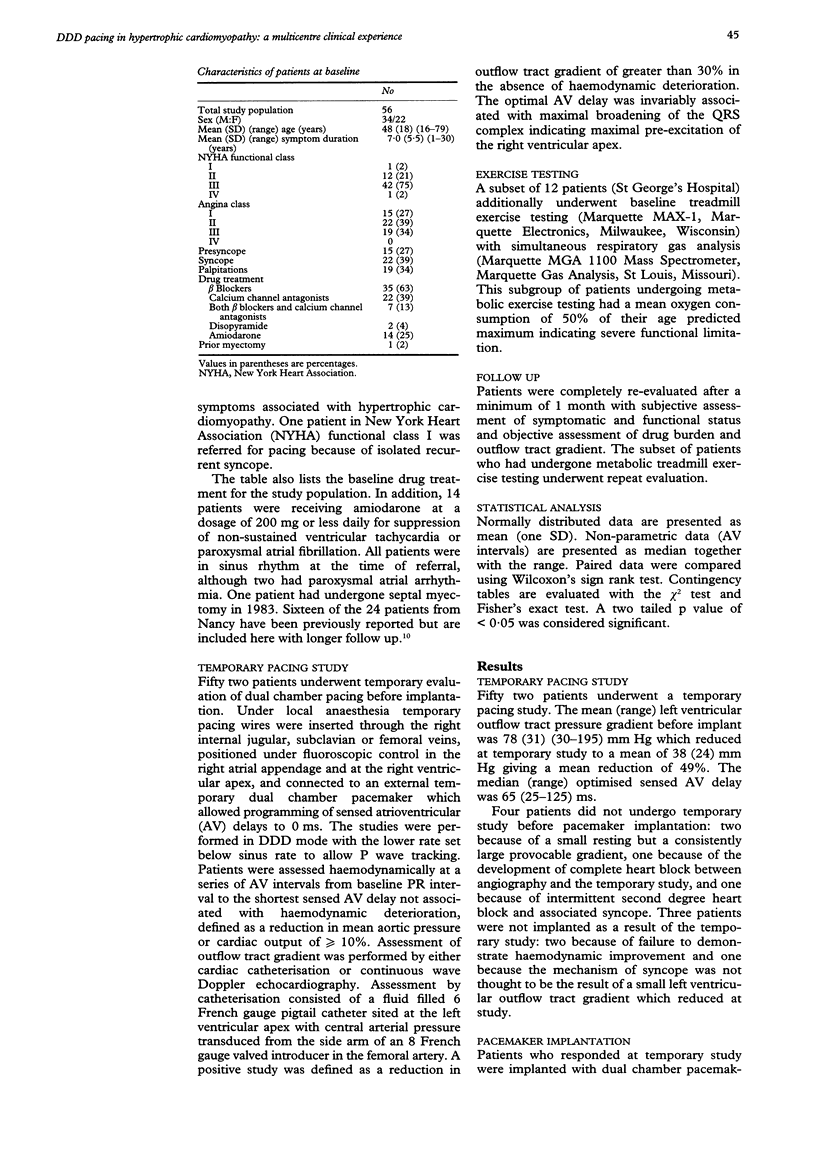
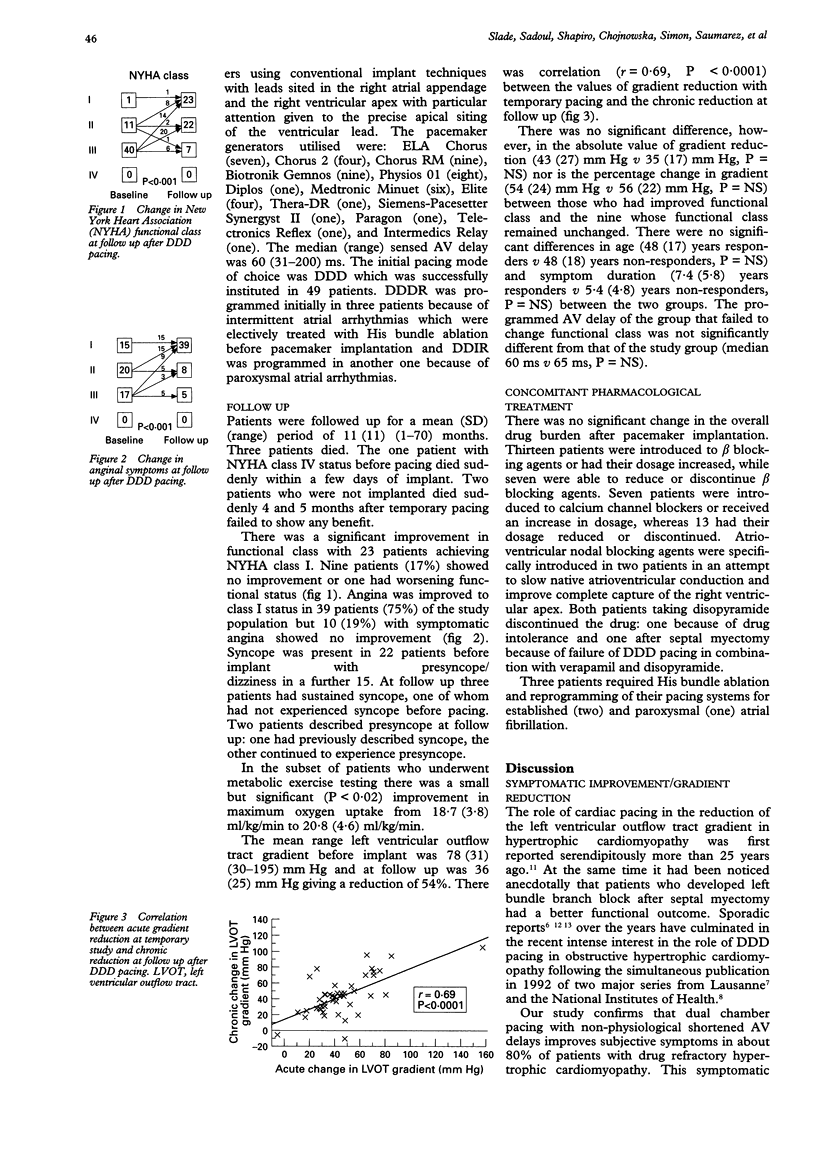
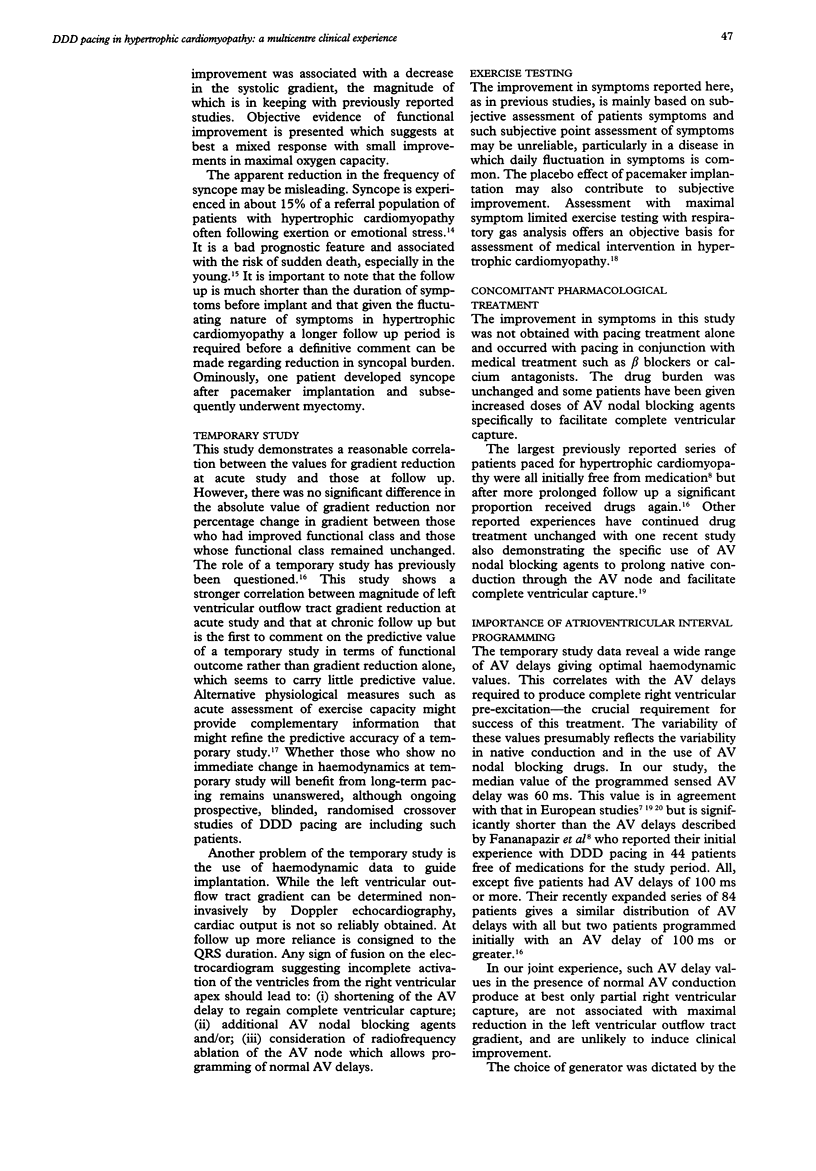
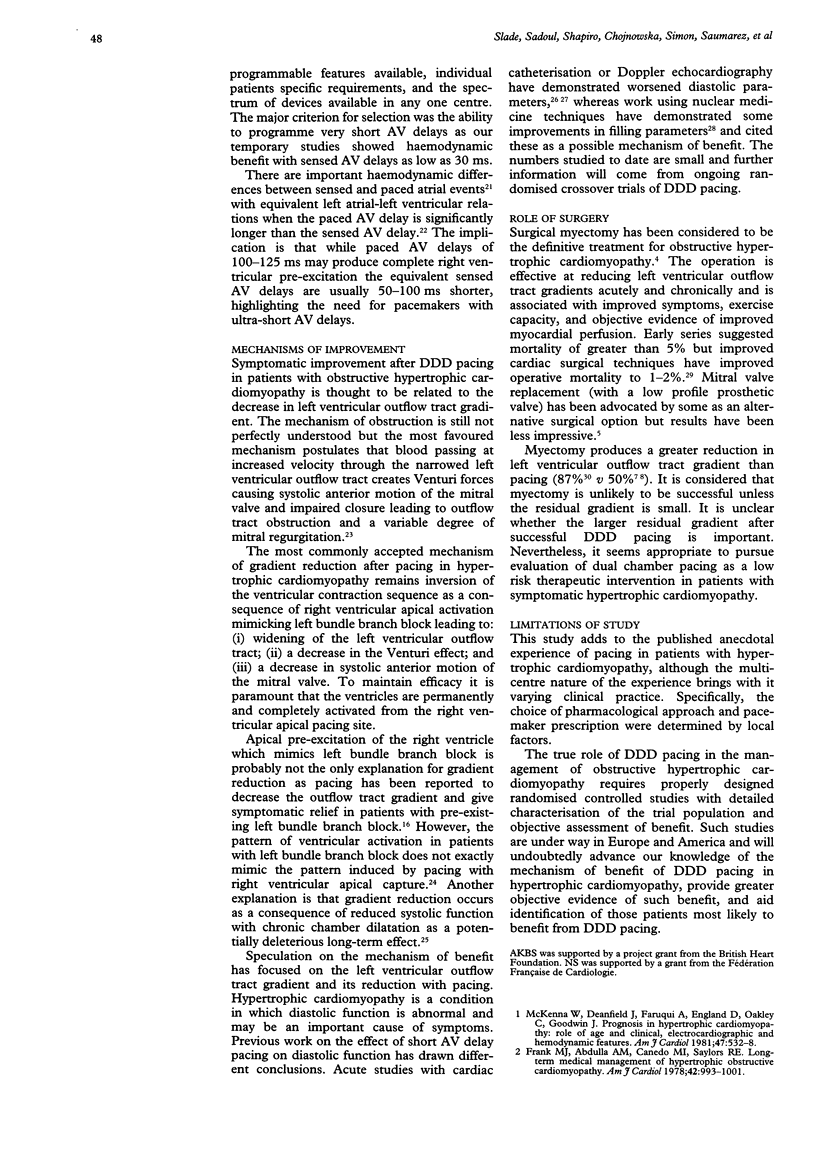
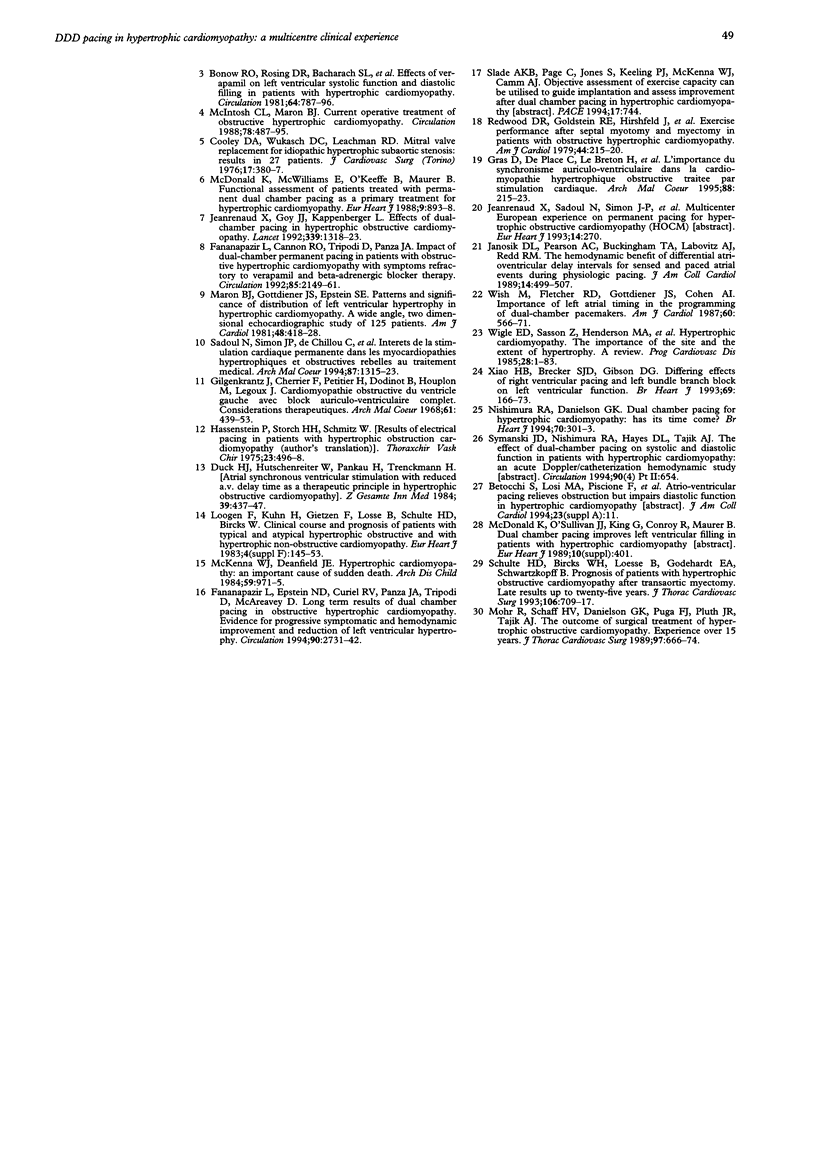
Selected References
These references are in PubMed. This may not be the complete list of references from this article.
- Bonow R. O., Rosing D. R., Bacharach S. L., Green M. V., Kent K. M., Lipson L. C., Maron B. J., Leon M. B., Epstein S. E. Effects of verapamil on left ventricular systolic function and diastolic filling in patients with hypertrophic cardiomyopathy. Circulation. 1981 Oct;64(4):787–796. doi: 10.1161/01.cir.64.4.787. [DOI] [PubMed] [Google Scholar]
- Cooley D. A., Wukasch D. C., Leachman R. D. Mitral valve replacement for idiopathic hypertrophic subaortic stenosis. Results in 27 patients. J Cardiovasc Surg (Torino) 1976 Sep-Oct;17(5):380–387. [PubMed] [Google Scholar]
- Fananapazir L., Cannon R. O., 3rd, Tripodi D., Panza J. A. Impact of dual-chamber permanent pacing in patients with obstructive hypertrophic cardiomyopathy with symptoms refractory to verapamil and beta-adrenergic blocker therapy. Circulation. 1992 Jun;85(6):2149–2161. doi: 10.1161/01.cir.85.6.2149. [DOI] [PubMed] [Google Scholar]
- Fananapazir L., Epstein N. D., Curiel R. V., Panza J. A., Tripodi D., McAreavey D. Long-term results of dual-chamber (DDD) pacing in obstructive hypertrophic cardiomyopathy. Evidence for progressive symptomatic and hemodynamic improvement and reduction of left ventricular hypertrophy. Circulation. 1994 Dec;90(6):2731–2742. doi: 10.1161/01.cir.90.6.2731. [DOI] [PubMed] [Google Scholar]
- Frank M. J., Abdulla A. M., Canedo M. I., Saylors R. E. Long-term medical management of hypertrophic obstructive cardiomyopathy. Am J Cardiol. 1978 Dec;42(6):993–1001. doi: 10.1016/0002-9149(78)90687-2. [DOI] [PubMed] [Google Scholar]
- Gilgenkrantz J. M., Cherrier F., Petitier H., Dodinot B., Houplon M., Legoux J. Cardiomyopathie obstructive du ventricule gauche avec bloc auriculo-ventriculaire complet. Considérations thérapeutiques. Arch Mal Coeur Vaiss. 1968 Mar;61(3):439–453. [PubMed] [Google Scholar]
- Gras D., de Place C., Le Breton H., Leclercq C., Paillard F., Mabo P., Daubert C. L'importance du synchronisme auriculo-ventriculaire dans la cardiomyopathie hypertrophique obstructive traitée par stimulation cardiaque. Arch Mal Coeur Vaiss. 1995 Feb;88(2):215–223. [PubMed] [Google Scholar]
- Janosik D. L., Pearson A. C., Buckingham T. A., Labovitz A. J., Redd R. M. The hemodynamic benefit of differential atrioventricular delay intervals for sensed and paced atrial events during physiologic pacing. J Am Coll Cardiol. 1989 Aug;14(2):499–507. doi: 10.1016/0735-1097(89)90208-8. [DOI] [PubMed] [Google Scholar]
- Jeanrenaud X., Goy J. J., Kappenberger L. Effects of dual-chamber pacing in hypertrophic obstructive cardiomyopathy. Lancet. 1992 May 30;339(8805):1318–1323. doi: 10.1016/0140-6736(92)91961-7. [DOI] [PubMed] [Google Scholar]
- Loogen F., Kuhn H., Gietzen F., Lösse B., Schulte H. D., Bircks W. Clinical course and prognosis of patients with typical and atypical hypertrophic obstructive and with hypertrophic non-obstructive cardiomyopathy. Eur Heart J. 1983 Nov;4 (Suppl F):145–153. doi: 10.1093/eurheartj/4.suppl_f.145. [DOI] [PubMed] [Google Scholar]
- Maron B. J., Gottdiener J. S., Epstein S. E. Patterns and significance of distribution of left ventricular hypertrophy in hypertrophic cardiomyopathy. A wide angle, two dimensional echocardiographic study of 125 patients. Am J Cardiol. 1981 Sep;48(3):418–428. doi: 10.1016/0002-9149(81)90068-0. [DOI] [PubMed] [Google Scholar]
- McDonald K., McWilliams E., O'Keeffe B., Maurer B. Functional assessment of patients treated with permanent dual chamber pacing as a primary treatment for hypertrophic cardiomyopathy. Eur Heart J. 1988 Aug;9(8):893–898. doi: 10.1093/oxfordjournals.eurheartj.a062584. [DOI] [PubMed] [Google Scholar]
- McIntosh C. L., Maron B. J. Current operative treatment of obstructive hypertrophic cardiomyopathy. Circulation. 1988 Sep;78(3):487–495. doi: 10.1161/01.cir.78.3.487. [DOI] [PubMed] [Google Scholar]
- McKenna W. J., Deanfield J. E. Hypertrophic cardiomyopathy: an important cause of sudden death. Arch Dis Child. 1984 Oct;59(10):971–975. doi: 10.1136/adc.59.10.971. [DOI] [PMC free article] [PubMed] [Google Scholar]
- Mohr R., Schaff H. V., Danielson G. K., Puga F. J., Pluth J. R., Tajik A. J. The outcome of surgical treatment of hypertrophic obstructive cardiomyopathy. Experience over 15 years. J Thorac Cardiovasc Surg. 1989 May;97(5):666–674. [PubMed] [Google Scholar]
- Nishimura R. A., Danielson G. K. Dual chamber pacing for hypertrophic obstructive cardiomyopathy: has its time come? Br Heart J. 1993 Oct;70(4):301–303. doi: 10.1136/hrt.70.4.301. [DOI] [PMC free article] [PubMed] [Google Scholar]
- Rawles J. Halving of mortality at 1 year by domiciliary thrombolysis in the Grampian Region Early Anistreplase Trial (GREAT). J Am Coll Cardiol. 1994 Jan;23(1):1–5. doi: 10.1016/0735-1097(94)90494-4. [DOI] [PubMed] [Google Scholar]
- Redwood D. R., Goldstein R. E., Hirshfeld J., Borer J. S., Morganroth J., Morrow A. G., Epstein S. E. Exercise performance after septal myotomy and myectomy in patients with obstructive hypertrophic cardiomyopathy. Am J Cardiol. 1979 Aug;44(2):215–220. doi: 10.1016/0002-9149(79)90307-2. [DOI] [PubMed] [Google Scholar]
- Sadoul N., Simon J. P., de Chillou C., Bruntz J. F., Isaaz K., Beurrier D., Reeb T., Dodinot B., Aliot E. Intérêts de la stimulation cardiaque permanente dans les myocardiopathies hypertrophiques et obstructives rebelles au traitement médical. Arch Mal Coeur Vaiss. 1994 Oct;87(10):1315–1323. [PubMed] [Google Scholar]
- Schulte H. D., Bircks W. H., Loesse B., Godehardt E. A., Schwartzkopff B. Prognosis of patients with hypertrophic obstructive cardiomyopathy after transaortic myectomy. Late results up to twenty-five years. J Thorac Cardiovasc Surg. 1993 Oct;106(4):709–717. [PubMed] [Google Scholar]
- Wigle E. D., Sasson Z., Henderson M. A., Ruddy T. D., Fulop J., Rakowski H., Williams W. G. Hypertrophic cardiomyopathy. The importance of the site and the extent of hypertrophy. A review. Prog Cardiovasc Dis. 1985 Jul-Aug;28(1):1–83. doi: 10.1016/0033-0620(85)90024-6. [DOI] [PubMed] [Google Scholar]
- Wish M., Fletcher R. D., Gottdiener J. S., Cohen A. I. Importance of left atrial timing in the programming of dual-chamber pacemakers. Am J Cardiol. 1987 Sep 1;60(7):566–571. doi: 10.1016/0002-9149(87)90306-7. [DOI] [PubMed] [Google Scholar]
- Xiao H. B., Brecker S. J., Gibson D. G. Differing effects of right ventricular pacing and left bundle branch block on left ventricular function. Br Heart J. 1993 Feb;69(2):166–173. doi: 10.1136/hrt.69.2.166. [DOI] [PMC free article] [PubMed] [Google Scholar]


